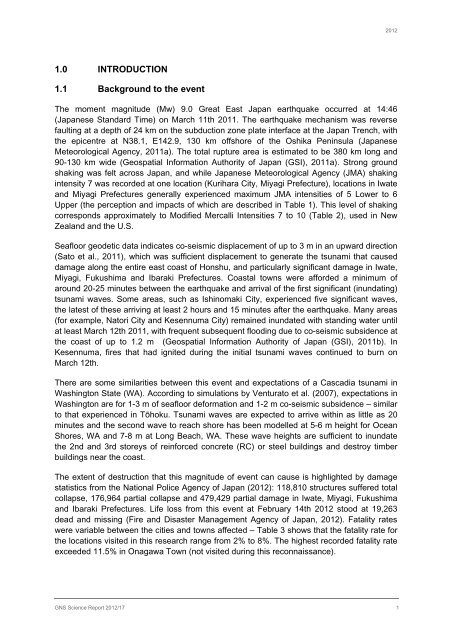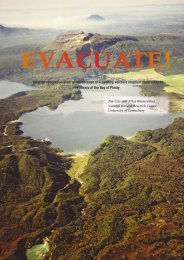Tsunami evacuation: Lessons from the Great East Japan earthquake ...
Tsunami evacuation: Lessons from the Great East Japan earthquake ...
Tsunami evacuation: Lessons from the Great East Japan earthquake ...
Create successful ePaper yourself
Turn your PDF publications into a flip-book with our unique Google optimized e-Paper software.
2012<br />
1.0 INTRODUCTION<br />
1.1 Background to <strong>the</strong> event<br />
The moment magnitude (Mw) 9.0 <strong>Great</strong> <strong>East</strong> <strong>Japan</strong> <strong>earthquake</strong> occurred at 14:46<br />
(<strong>Japan</strong>ese Standard Time) on March 11th 2011. The <strong>earthquake</strong> mechanism was reverse<br />
faulting at a depth of 24 km on <strong>the</strong> subduction zone plate interface at <strong>the</strong> <strong>Japan</strong> Trench, with<br />
<strong>the</strong> epicentre at N38.1, E142.9, 130 km offshore of <strong>the</strong> Oshika Peninsula (<strong>Japan</strong>ese<br />
Meteorological Agency, 2011a). The total rupture area is estimated to be 380 km long and<br />
90-130 km wide (Geospatial Information Authority of <strong>Japan</strong> (GSI), 2011a). Strong ground<br />
shaking was felt across <strong>Japan</strong>, and while <strong>Japan</strong>ese Meteorological Agency (JMA) shaking<br />
intensity 7 was recorded at one location (Kurihara City, Miyagi Prefecture), locations in Iwate<br />
and Miyagi Prefectures generally experienced maximum JMA intensities of 5 Lower to 6<br />
Upper (<strong>the</strong> perception and impacts of which are described in Table 1). This level of shaking<br />
corresponds approximately to Modified Mercalli Intensities 7 to 10 (Table 2), used in New<br />
Zealand and <strong>the</strong> U.S.<br />
Seafloor geodetic data indicates co-seismic displacement of up to 3 m in an upward direction<br />
(Sato et al., 2011), which was sufficient displacement to generate <strong>the</strong> tsunami that caused<br />
damage along <strong>the</strong> entire east coast of Honshu, and particularly significant damage in Iwate,<br />
Miyagi, Fukushima and Ibaraki Prefectures. Coastal towns were afforded a minimum of<br />
around 20-25 minutes between <strong>the</strong> <strong>earthquake</strong> and arrival of <strong>the</strong> first significant (inundating)<br />
tsunami waves. Some areas, such as Ishinomaki City, experienced five significant waves,<br />
<strong>the</strong> latest of <strong>the</strong>se arriving at least 2 hours and 15 minutes after <strong>the</strong> <strong>earthquake</strong>. Many areas<br />
(for example, Natori City and Kesennuma City) remained inundated with standing water until<br />
at least March 12th 2011, with frequent subsequent flooding due to co-seismic subsidence at<br />
<strong>the</strong> coast of up to 1.2 m (Geospatial Information Authority of <strong>Japan</strong> (GSI), 2011b). In<br />
Kesennuma, fires that had ignited during <strong>the</strong> initial tsunami waves continued to burn on<br />
March 12th.<br />
There are some similarities between this event and expectations of a Cascadia tsunami in<br />
Washington State (WA). According to simulations by Venturato et al. (2007), expectations in<br />
Washington are for 1-3 m of seafloor deformation and 1-2 m co-seismic subsidence – similar<br />
to that experienced in Tōhoku. <strong>Tsunami</strong> waves are expected to arrive within as little as 20<br />
minutes and <strong>the</strong> second wave to reach shore has been modelled at 5-6 m height for Ocean<br />
Shores, WA and 7-8 m at Long Beach, WA. These wave heights are sufficient to inundate<br />
<strong>the</strong> 2nd and 3rd storeys of reinforced concrete (RC) or steel buildings and destroy timber<br />
buildings near <strong>the</strong> coast.<br />
The extent of destruction that this magnitude of event can cause is highlighted by damage<br />
statistics <strong>from</strong> <strong>the</strong> National Police Agency of <strong>Japan</strong> (2012): 118,810 structures suffered total<br />
collapse, 176,964 partial collapse and 479,429 partial damage in Iwate, Miyagi, Fukushima<br />
and Ibaraki Prefectures. Life loss <strong>from</strong> this event at February 14th 2012 stood at 19,263<br />
dead and missing (Fire and Disaster Management Agency of <strong>Japan</strong>, 2012). Fatality rates<br />
were variable between <strong>the</strong> cities and towns affected – Table 3 shows that <strong>the</strong> fatality rate for<br />
<strong>the</strong> locations visited in this research range <strong>from</strong> 2% to 8%. The highest recorded fatality rate<br />
exceeded 11.5% in Onagawa Town (not visited during this reconnaissance).<br />
GNS Science Report 2012/17 1

















